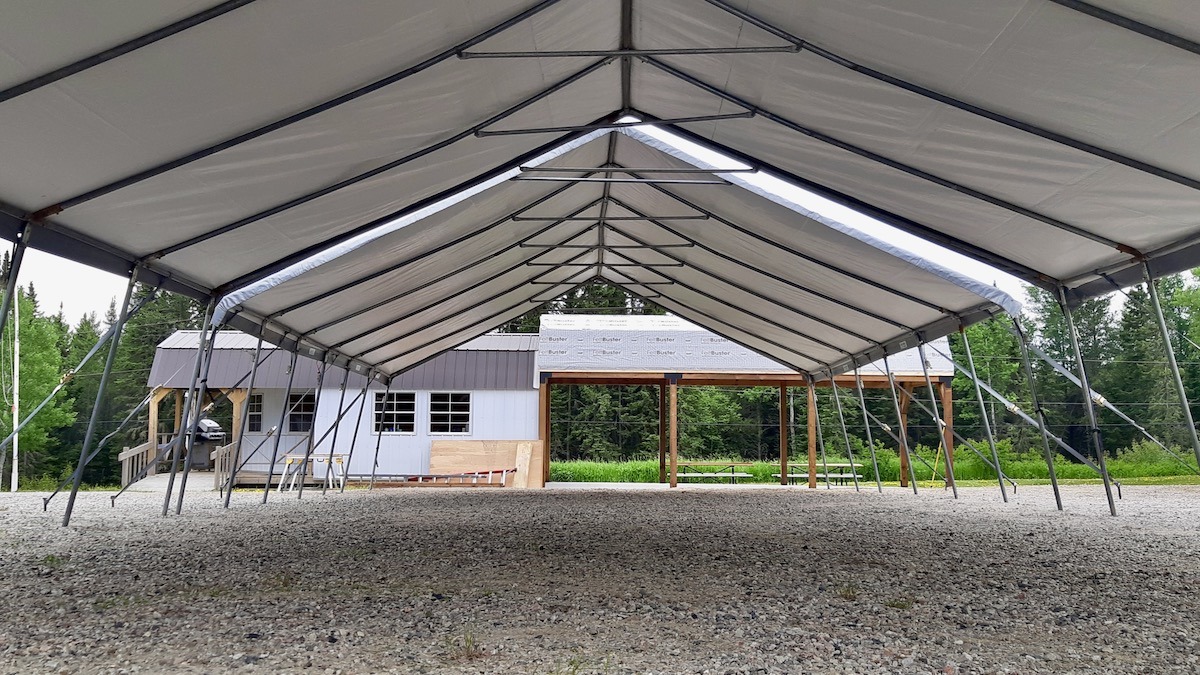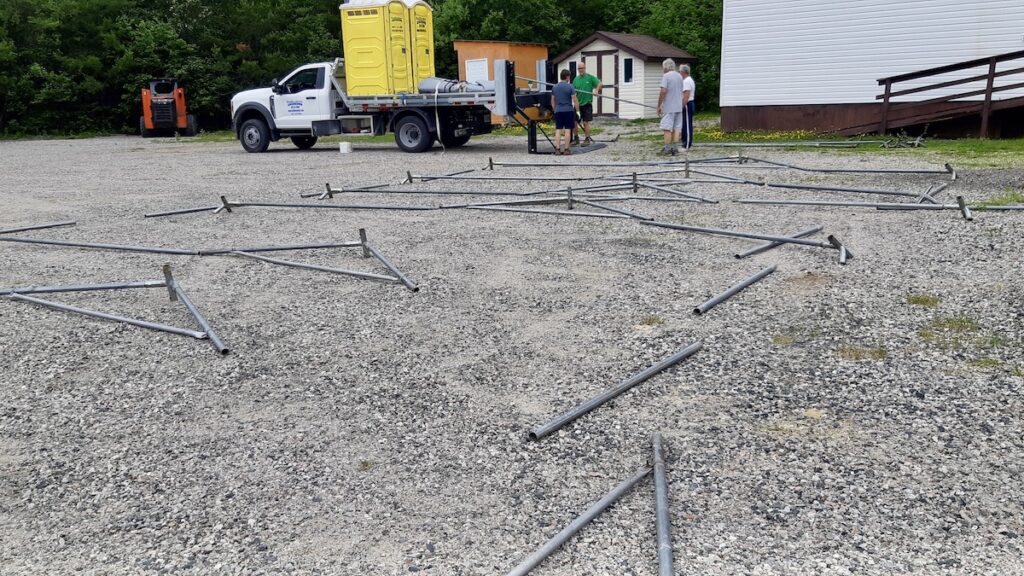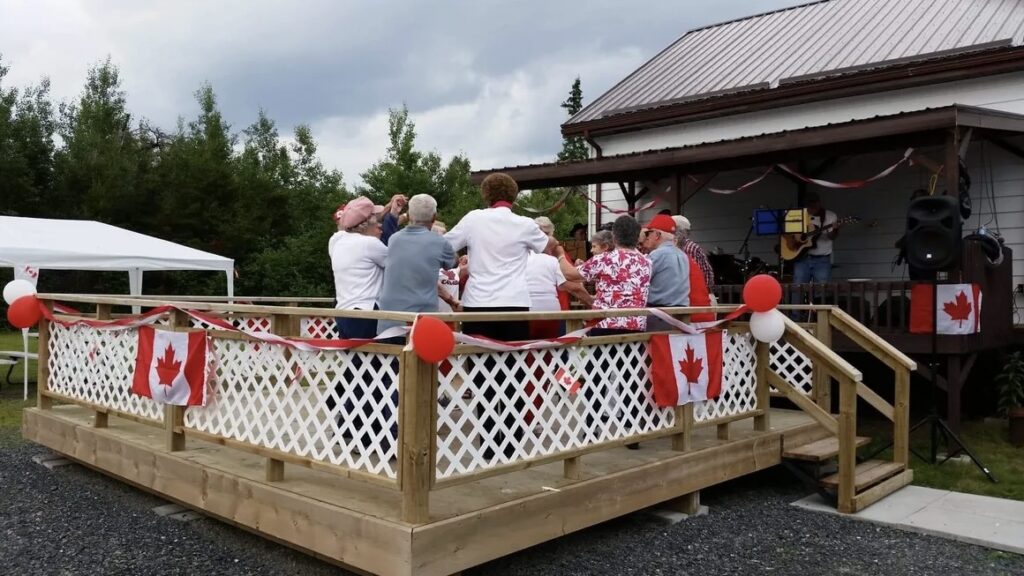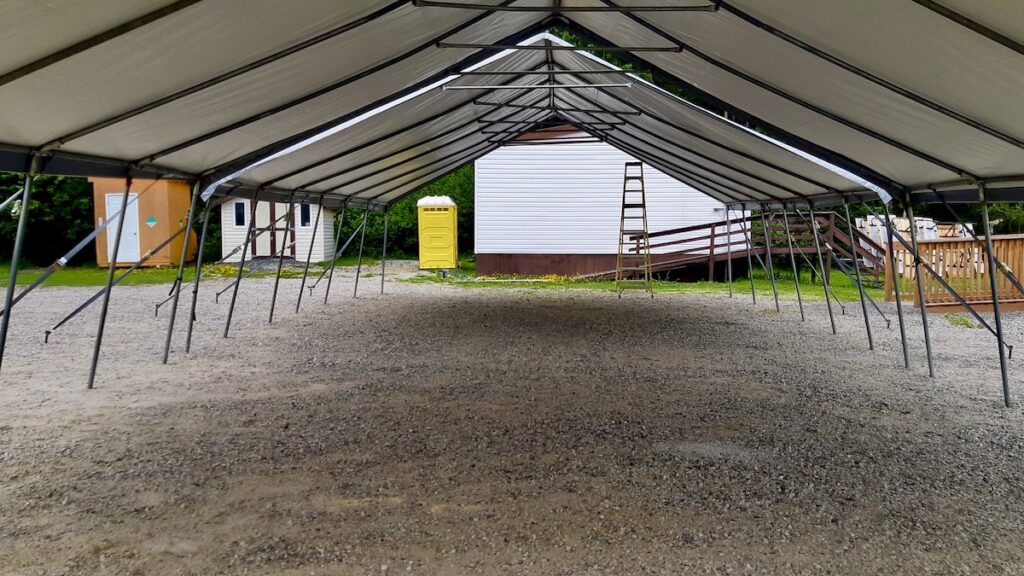
The Dyment Recreation Complex in Melgund Township has new event tents, perfect for music, arts and community events.
I. The Outdoor Event Space: A Readily Activated Asset, Poised for Greater Impact
The community Outdoor Event Space, primarily defined by its highly functional and easily deployable seasonal large event tents (erected from June to August), represents a significantly valuable and accessible asset for the community’s outdoor arts, culture, and recreation. These tents are a tangible positive development, requiring remarkably little effort beyond a dedicated team for setup and tear-down, making them an efficient and immediate enhancement to the communities’ capacity for hosting a wide array of gatherings, performances, and activities that would otherwise be impractical. While a strong asset, its maximum potential is still constrained by underlying operational challenges within the complex that prevent a fully realized and integrated community benefit.

A. Current State: A Functional and Effortless Foundation for Seasonal Vibrancy
The Outdoor Event Space, particularly with its large event tents, provides a functional and attractive venue for community gatherings with minimal overhead.
- Valuable & Easily Deployable Seasonal Addition: The large event tents are a significant and highly valuable enhancement to the communities’ recreational and cultural infrastructure. Their seasonal deployment from June to August is notably straightforward, requiring little effort beyond a capable team for efficient setup and tear-down. This operational simplicity provides much-needed sheltered space for outdoor activities, extending the usability of the site and protecting participants from the elements with a low barrier to activation. This directly contributes to the community’s quality of life during peak outdoor months.
- Enhanced & Accessible Event Capacity: These tents dramatically increase the communities’ capacity to host larger, more diverse outdoor events, including festivals, markets, performances, and community celebrations. They offer flexibility and a clearly defined space that is inherently easy to adapt for various purposes, making event planning more feasible and attractive to potential organizers due to the ready-to-use nature of the core infrastructure.
- Visual Appeal and Practicality: When erected, the tents transform the open ground into a designated, welcoming event area. Their presence signifies a commitment to providing quality outdoor experiences, making them a practical and aesthetically pleasing focal point for summer activities that are simple to bring to life.

B. Identified Gaps: Opportunities for Optimization and Broader Reach
While the tents are an easily activated and strong asset, certain limitations prevent the Outdoor Event Space from realizing its full, year-round potential and integrating seamlessly with broader community needs.
- Seasonal Limitation: The primary limitation is the seasonal nature of the tents. While essential for summer, the space lacks permanent, weather-resistant structures that could facilitate year-round outdoor programming or offer shelter during transitional seasons (spring/fall) or inclement weather, preventing continuous use despite the low setup effort.
- Digital Infrastructure Deficit: Despite the physical improvements, the Outdoor Event Space inherently suffers from the same critical absence of reliable internet or modern presentation capabilities that plagues other recreation facilities. This fundamental deficiency hampers digital ticketing, live streaming of events, real-time communication, and sophisticated event promotion, creating a barrier to broader engagement and modern outreach strategies, even for easily organized events.
- Limited Permanent Amenities: Beyond the easily deployable tents, there may be a lack of robust permanent infrastructure such as dedicated, accessible power sources, readily available permanent washroom facilities (beyond temporary solutions), or integrated sound/lighting systems. These omissions, while not impeding basic tent setup, limit the scope and professionalism of larger-scale events without significant additional, event-specific effort.
- Dependence on Ad-Hoc Planning: While the tents are an asset with low activation effort, the overall programming for the Outdoor Event Space often still suffers from the recreation department’s general lack of structured, strategic planning and reliance on ad-hoc arrangements. This prevents the cultivation of a diverse, regular calendar of events, despite the inherent simplicity of deploying the venue.

C. Leveraging Potential: Aligning with the Framework for Recreation in Canada
The Outdoor Event Space, particularly with its large event tents, possesses immense and readily achievable potential to align directly with the Framework for Recreation in Canada (2024 Update), albeit with opportunities for further strategic optimization:
- Goal 1: Active Living:
- Potential: The easily defined and sheltered space is ideal for readily organizing large-scale active events like community runs, outdoor fitness classes, dance performances, and youth sports clinics that require open, protected areas. It can effortlessly host diverse cultural festivals that encourage active participation.
- Current Contribution: The tents are already contributing positively by enabling such events during the summer months with minimal logistical barriers for the space itself, actively fostering physical activity and vibrant gatherings.
- Goal 2: Inclusion and Access:
- Potential: The large, open nature of the space, especially with the tents providing accessible shelter, makes it highly conducive to easily organized, inclusive programming, welcoming diverse community members to participate in outdoor arts, cultural, and recreational activities.
- Current Contribution: By providing an easily deployable venue for public events like Canada Day and Family Day, the space already promotes broad community access and inclusion, serving as a vital and straightforward gathering point for residents.
- Goal 3: Connecting People with Nature:
- Potential: As an outdoor venue, it inherently connects people with the local environment with little additional effort. It could easily host nature education workshops, outdoor art installations inspired by the landscape, or serve as a straightforward starting/ending point for guided nature walks and environmental awareness campaigns.
- Current Contribution: Its outdoor setting naturally facilitates a connection to nature, offering a space where community members can gather and engage with their natural surroundings during events, a benefit easily provided by the tents.
- Goal 4: Supportive Environments:
- Potential: The tents create a safe, designated, and comfortable environment for immediate social interaction and community building during events. With minor enhancements and consistent scheduling, it could become a recognized, accessible hub for spontaneous and planned social gatherings.
- Current Contribution: The space already acts as a vibrant social hub during its operational season, fostering positive community interactions and strengthening local bonds through shared experiences at events, demonstrating its inherent ease in creating supportive atmospheres.
- Goal 5: Recreation Capacity:
- Potential: The large event tents fundamentally increase the LSB’s overall recreational and cultural capacity with remarkable operational ease, providing a high-quality venue for large-scale outdoor activities. This readily available asset is invaluable for attracting partnerships, hosting regional events, and securing grants specifically for outdoor programming.
- Current Contribution: This space is a clear demonstration of expanded recreational capacity, allowing for events that would be impossible without the tents, thereby showcasing a tangible commitment to community enhancement with a low activation threshold.
D. Conclusion: A Strong, Easily Leveraged Foundation, Awaiting Full Strategic Activation
The Outdoor Event Space, anchored by its highly functional and remarkably easy-to-deploy large event tents, represents a significant and readily available positive asset for the recreation department and the broader community’s recreational and cultural life. It demonstrably enhances capacity for outdoor programming and contributes to vibrant seasonal events with minimal operational friction for the venue itself. However, its full, year-round potential remains partially untapped due to limitations in permanent infrastructure, the persistent digital infrastructure deficit, and the overarching need for more consistent, strategic planning and robust community engagement from the communities. Fully leveraging this promising asset will require addressing these systemic issues beyond the tents’ operational simplicity, ensuring it becomes not just a seasonal highlight, but a cornerstone of sustainable, diverse, and accessible community programming year-round.




